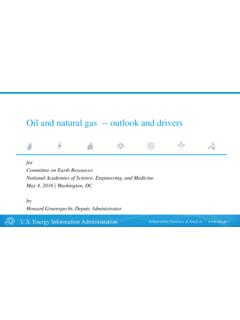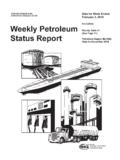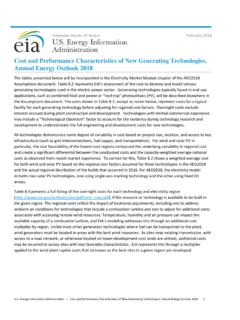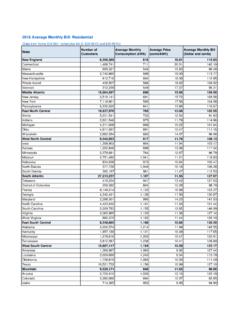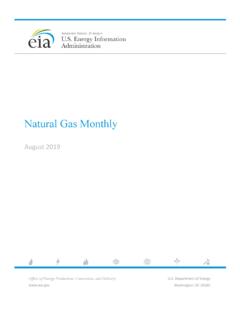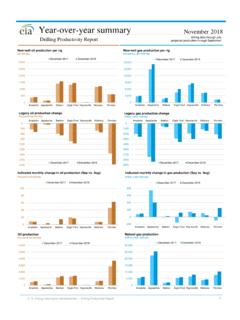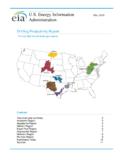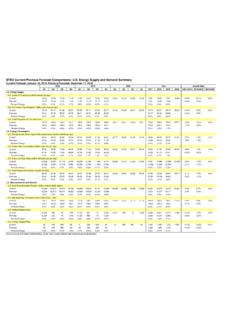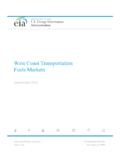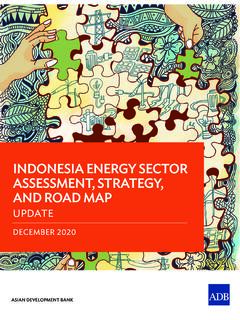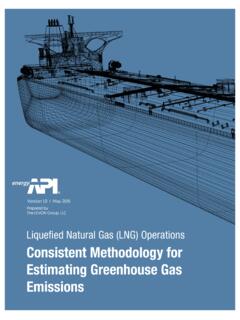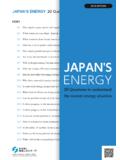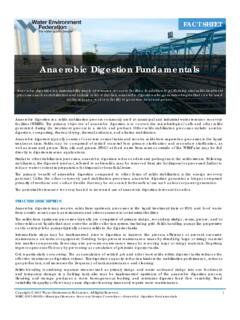Transcription of Marine Fuel Choice for Ocean- Going Vessels within ...
1 Marine Fuel Choice for Ocean- Going Vessels within Emissions Control Areas June 2015 Independent Statistics & Analysis Department of Energy Washington, DC 20585 Energy Information Administration | Marine fuel Choice for ocean Going Vessels within emissions control areas i This report was prepared by the Energy Information Administration (EIA), the statistical and analytical agency within the Department of Energy. By law, EIA s data, analyses, and forecasts are independent of approval by any other officer or employee of the United States Government. The views in this report therefore should not be construed as representing those of the Department of Energy or other Federal 2015 Energy Information Administration | Marine fuel Choice for ocean Going Vessels within emissions control areas 1 Introduction The Energy Information Administration (EIA) contracted with Leidos Corporation to analyze the impact on ocean- Going vessel fuel usage of the International Convention for the Prevention of Pollution from Ships (MARPOL) emissions control areas in North America and the Caribbean.
2 Leidos developed a new methodology for calculating fuel consumption by ocean- Going maritime Vessels in the United States within emission control areas by: Establishing a fuel usage methodology baseline for ocean- Going Vessels by Census Division and Puerto Rico for several ship types and energy and non-energy commodities Discussing relevant MARPOL and associated Environmental Protection Agency emissions regulations and major emissions compliance strategies, including exhaust scrubber controls, fuel switching to liquefied natural gas, and engine-based controls Creating a methodology for projecting ocean- Going vessel travel demand by commodity and ship type, ship efficiency, and fuel Choice by various compliance choices In addition, Leidos recommended study of additional issues for future model improvements as more data become available.
3 These include: Expanding the scope of the Marine fuel estimates to include travel beyond North American and Caribbean emission control areas and Great Lakes and inland waterway transit Expanding the scope to include fuel usage estimates tied to ports for tugs, barges, and lightering Vessels , fishing Vessels , cruise ships, and other commercial Vessels Fractioning the fuel purchases made in the United States versus abroad Improving the future projections of fuel usage, including slow steaming and auxiliary power needs, and technology adoption EIA plans to update the upcoming Annual Energy Outlook 2016 to include a new methodology for calculating the amount of fuel consumption by ocean- Going Vessels traveling though North American and Caribbean emissions control areas, including the impact of compliance strategies.
4 Further, EIA plans to update the methodology for calculating ocean Going vessel energy demand to include estimation of fuel consumption by ship type and commodity moved. The new methodology will also estimate energy consumption within and outside emission control areas. In addition, EIA will explore the interplay between refinery operation, refined product slates, and Marine fuels in light of the impact of emission regulations. June 2015 Energy Information Administration | Marine fuel Choice for ocean Going Vessels within emissions control areas 2 Appendix A Marine Fuel Choice for Ocean Going Vessels within Emission Control Areas EIA Task 7965, Subtask 17 Prepared for: Energy Information Administration Office of Energy Analysis Office of Energy Consumption and Efficiency Analysis Prepared by: Leidos Corporation Steve O Malley, Ken Walsh, Adam Hasen, Delma Bratvold, and Jay Ratafia-Brown FINAL REPORT April 2015 i Disclaimer Certain statements included in this report constitute forward-looking statements.
5 The achievement of certain results or other expectations contained in such forward-looking statements involve known and unknown risks, uncertainties and other factors which may cause actual results, performance or achievements described in the report to be materially different from any future results, performance or achievements expressed or implied by such forward-looking statements. We do not plan to issue any updates or revisions to the forward-looking statements if or when our expectations or events, conditions, or circumstances on which such statements are based occur. ii Table of Contents List of Tables .. iii List of Figures .. iv List of Abbreviations and Acronyms .. v Executive Summary .. vii 1 Introduction.
6 1 2 Baseline Current Estimates .. 2 Grouping the Ships .. 3 Determining Engine Size and Design Speed of Each Ship 5 Calculating Fuel Oil Consumption .. 8 Time ship will be operating in the ECA .. 9 Power consumption in propelling the ships through the ECA .. 11 Auxiliary power 11 Fuel consumed in 2012 .. 13 Distribution Between Energy and Non-Energy Products .. 15 Determining percentage of tankers and dry bulk ships transporting energy products 15 Determining number of gas carriers (ships) that are transporting LNG and LPG .. 16 3 Compliance Strategies .. 19 Regulatory Framework .. 19 EPA regulations .. 19 IMO protocols .. 21 Major Compliance Strategies .. 22 Strategy A Exhaust Controls .. 22 Strategy B LNG-fueled Vessels .. 26 Strategy C Engine-based controls.
7 27 Other Compliance Options 28 Compliance Cost Issues .. 29 4 Projections to Future Years .. 31 Increased Efficiency of New Vessels .. 31 Changes in Shipping Demands .. 32 Compliance Choices .. 36 Fuel Estimates .. 40 5 Recommendations .. 42 Appendix A. Matrix-Based Derivations of Baseline Estimates .. 45 Appendix B. Ship Routes to Avoid Significant Travel in North American ECA .. 47 Appendix C. Adoption of Compliance Strategies by Ship Industry .. 48 Appendix D. Computation of Port Times .. 55 iii List of Tables Table 2-1. Estimating Average DWT of Tanker Ships Operating in the Pacific .. 3 Table 2-2. Ship Engine Output for Each Ship Profile .. 6 Table 2-3. Ship Design Speed for Each Ship Profile .. 6 Table 2-4. Slow Speed Steaming Reduction in Ship Speed by Vessel Type.
8 7 Table 2-5. Slow Speed Steaming Reduction in Ship Power Output by Vessel Type .. 8 Table 2-6. Fuel Oil Consumption Rates for Slow, Medium and High Speed Diesel Engines .. 8 Table 2-7. Power Spent for Propulsion through the ECA .. 11 Table 2-8. Auxiliary Power Spent in ECA and Port .. 12 Table 2-9. Fuel Oil Consumption Rates for Auxiliary Power .. 12 Table 2-10. Total Fuel Consumed in 2012 for Transit and Auxiliary Power .. 13 Table 2-11. Percentage of Product Moved on Tank Ships That are Energy Products (top). Percentage of Product Moved on Dry Bulk Ships that are Energy Products (bottom).. 16 Table 2-12. LNG Carriers as a Percentage of Total Gas Carriers .. 17 Table 2-13. Total Fuel Consumed in 2012 by Vessel Type and 18 Table 3-1. Marine Engine Categories .. 19 Table 3-2.
9 MARPOL Annex VI NOx Emission Standards .. 20 Table 3-3. MARPOL Annex VI Fuel Sulfur Limits Globally and within a SOx ECA .. 22 Table 4-1. ICCT List of Potential Fuel Reduction Technologies .. 32 Table 4-2. Weight Transported in 2012 Through Waters Now under the North American 33 Table 4-3. Energy Commodity Changes in the AEO 2014 Reference Case .. 33 Table 4-4. Potential NEMS Variables That Could Indicate Fleet Growth in Future Years .. 34 Table 4-5. Fleet Profiles of Compliance Strategies under Three Scenarios .. 39 Table 4-6. Total Fuel Consumed in North American and Caribbean ECAs in 2021 by Marine Fuel Type .. 40 Table 4-7. Total Fuel Consumed in North American and Caribbean ECAs in 2021 by NEMS Fuel Type .. 41 Table 5-1. Model Inputs for a Possible Technology Adoption Model for Fuel Use Projections.
10 44 iv List of Figures Figure ES- 1. Total 2012 Fuel Consumed by OGVs within ECAs by Census Divisions Based on Vessel Type .. viii Figure ES- 3. Sample Projections of Fuel Consumed within North American and Caribbean ECAs by NEMS Fuel ix Figure 2-1. Total Fuel Consumed in 2012 by Ship Type in Census Divisions That Have 3 Figure 2-3. Average DWT of Each Vessel Type by Census Division .. 5 Figure 2-4. Most Common Ship Bunker Fuels .. 9 Figure 2-5. Time Each Vessel Type Operated in the ECA Waters in 2012 .. 10 Figure 2-7. Fuel Consumption in ECA Waters in 14 v List of Abbreviations and Acronyms ACOE Army Corps of Engineers AEO Annual Energy Outlook Btu British thermal units CWA Clean Water Act CO2 carbon dioxide dwt dead weight tonnage C1, C2, & C3 Category 1, 2, and 3 ( Marine diesel engines) dm3 cubic decimeter (liter)
